Ovulation Testing
What is ovulation testing?
Most women who have menstrual periods every 24-35 days release eggs (ovulate). However, regular menses do not guarantee ovulation. If a woman does not release eggs (anovulation), she will not get pregnant. If she releases eggs infrequently (oligo-ovulation), her chances of getting pregnant are reduced.
It is important to know if and when ovulation occurs. Women should ovulate approximately 14 days prior to expected menses. Women who have fewer than 13 days between ovulation and menses have short luteal phases and may have reduced fertility.
Expert Treatment. Total Commitment. TRM.

At Tennessee Reproductive Medicine, you’ll find a team of professionals dedicated to delivering the highest quality of compassionate fertility care.
Types of ovulation testing
Tests of ovulatory function include basal body temperature charting, ovulation predictor kits and timed serum progesterone levels. We recommend against performing tests on salivary and cervical secretions, as these tests have not proven reliable.
Basal body temperature testing
Basal body temperature (BBT) testing measures subtle changes in a woman’s body temperature that occur due to ovulation. After ovulation, the ovary produces progesterone, which causes a woman’s temperature to increase by about ½ of a degree on the Fahrenheit scale.
When a special BBT thermometer is used on a daily basis, one can determine both if a woman ovulates and how long her luteal phase lasts. Proper technique is essential in order for your physician to interpret the results.
Basal body temperature charting technique
- Obtain a BBT thermometer, available at your drug store.
- Place the thermometer at your bedside.
- The day after your menses begin, start recording your temperature.
- Each morning, upon waking and before rising or any morning activity, and before drinking anything, take your temperature.
- Record the temperature on a BBT graph.
- Keep recording on a daily basis until your next menses begins.
- The temperature should remain elevated for at least 11 days.
- If you do not get a temperature rise, or if the rise does not last 11 days, consult your doctor.
As seen below, a normal temperature rise will last for a minimum of 11 days. It can take up to three days after ovulation for the temperature to rise. However, in our experience most women experience temperature rises on the same day or a day later than when an ovulation predictor kit turns positive.
Intercourse in the two to three days before the temperature rises is most likely to result in pregnancy.
BBT charts
Below are some examples of normal and abnormal BBT graphs. An abnormal BBT should be investigated. If you have questions about your BBT, let us help you evaluate and understand the information.
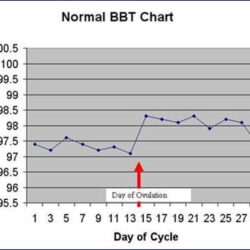
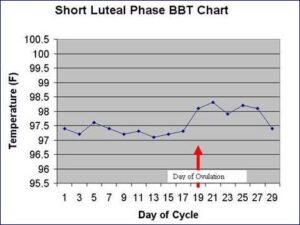
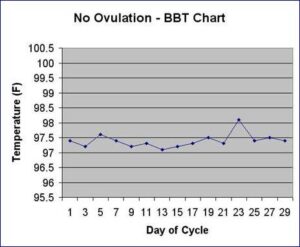
Ovulation predictor kits
An ovulation predictor kit (OPK) is another test that patients can use at home, which functions similarly to a home urine pregnancy test. OPKs measure the urinary level of luteinizing hormone (LH), the hormone that triggers ovulation.
Typically, LH levels rise rapidly in the 24 hours prior to ovulation. OPKs detect this rise, and are useful in helping couples know when to optimally time intercourse.
If menses occur within 12 days of the positive OPK result, the luteal phase may be too short to sustain a pregnancy, and a patient should consult her physician.
If you are unsure whether your OPK is positive or not, we can determine this with simple blood tests.
Optimizing your OPK test
A menstrual cycle is measured from the first day of one period until the first day of the next. In a 28-day cycle, ovulation most likely occurs in the two to three days around the 14th day of the cycle. The LH surge will precede this by one day, so you should begin testing on cycle day 11 to maximize the chance of detecting your surge.
Ovulation is likely to occur within 12-36 hours following a positive test. The optimal time for intercourse is the day after the positive test.
Try to test around the same time each day. Most test kits will instruct individuals to test with the second urination of the day. However, the LH rise is most likely to be detected if testing occurs in the mid-afternoon, from three to seven p.m.
While fluid restriction is not necessary, excessive fluid intake causing very dilute urine may limit the test’s ability to detect LH.
Below is an example of a classically positive OPK:
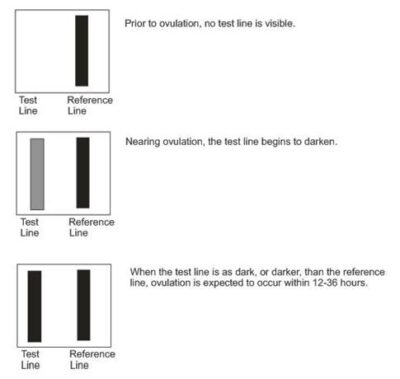
In our experience, relatively few women have classically positive results like the example here. Frequently, the LH surge looks more like the middle drawing. You may only know this if the kit darkens and the next day it fades. If this happens, have intercourse on the day it fades!
If you are uncertain if your test is positive, give us a call. Remember, simple blood tests can confirm whether this is a true LH surge or a false positive result.
Serum progesterone ovulation testing
Serum progesterone measurements are a reliable way to document ovulation. The human body produces very little progesterone, except during the luteal phase (two week period between ovulation and menses).
Ideally, progesterone is measured at its peak – usually seven days prior to expected menses. Thus, in a 28-day cycle, we would measure on day 21. In a 35-day cycle, we would measure on day 28.
Progesterone level interpretation
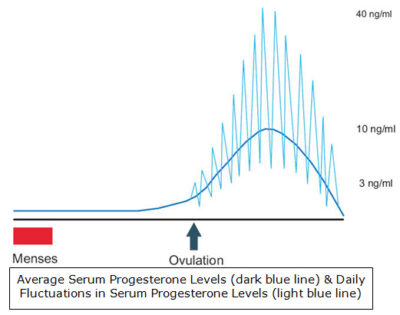
In our experience, progesterone level interpretation is one of the most misunderstood fertility evaluations, by patients and doctors alike. A common misconception is that a progesterone must be 10 ng/ml or greater to confirm good quality ovulation. In truth, there is a lot of variation in progesterone levels over the course of 90 minutes. Some studies have shown that progesterone levels can vary from as low as 2 ng/ml to 40 ng/ml within the same day.
A low progesterone level could mean that the level was drawn close to ovulation or close to menses (rather than at the peak in the mid-luteal phase). Additionally, a low progesterone level could simply mean that the blood was drawn at a time when the level briefly fluctuated down.
Since it is not feasible to continuously sample a woman’s blood and plot the change in her progesterone levels throughout her luteal phase, progesterone levels are best used to confirm that ovulation occurred (when levels are > 3 ng/ml).
Beyond that, the length of the luteal phase is more informative about adequacy of progesterone production than the absolute progesterone level.
Progesterone levels and miscarriage
Patients suffering from prior miscarriage(s) commonly ask whether they need supplemental progesterone in pregnancy, because they were told during prior miscarriages that their progesterone level was “low.” In fact, low progesterone levels in pregnancy are almost always a symptom of an abnormally developing pregnancy (either in the uterus or in the tubes) rather than a cause of miscarriage.
Cervical mucus tests
Around the time of ovulation, estrogen levels rise and cause more water to be secreted into the cervical mucus. The mucus can become thinner, or stretch more when held between the fingers. Women can check their own cervical mucus to see if it becomes thinner.
Some women can reliably predict ovulation this way, and for them, it correlates to ovulation predictor kits and basal body temperature charting. However, studies have shown that cervical mucus testing is less accurate than urinary ovulation predictor kit testing, because some women perceive a change in mucus even when ovulation does not occur.
Nevertheless, there is little harm in checking for cervical mucus changes. We recommend that cervical mucus testing not be the only method used to determine ovulation.
Salivary ferning microscope tests
These have been shown to be unreliable and we do not recommend them. Salivary ferning microscope tests will sometimes even show that men and post-menopausal women are ovulating. Clearly, these results cannot be interpreted with any confidence.

